fold seats SKODA ROOMSTER 2009 1.G Owner's Manual
[x] Cancel search | Manufacturer: SKODA, Model Year: 2009, Model line: ROOMSTER, Model: SKODA ROOMSTER 2009 1.GPages: 263, PDF Size: 32.25 MB
Page 47 of 263
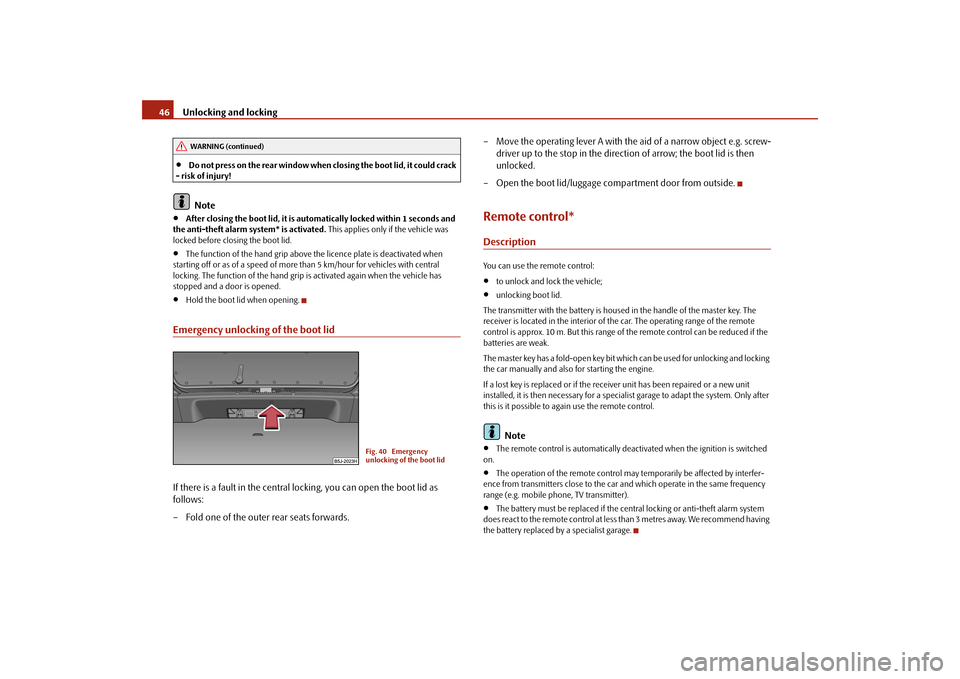
Unlocking and locking 46•
Do not press on the rear window when closing the boot lid, it could crack
- risk of injury!Note
•
After closing the boot lid, it is automatically locked within 1 seconds and
the anti-theft alarm system* is activated. This applies only if the vehicle was
locked before closing the boot lid.
•
The function of the hand grip above the licence plate is deactivated when
starting off or as of a speed of more than 5 km/hour for vehicles with central
locking. The function of the hand grip is activated again when the vehicle has
stopped and a door is opened.
•
Hold the boot lid when opening.
Emergency unlocking of the boot lidIf there is a fault in the central locking, you can open the boot lid as
follows:
– Fold one of the outer rear seats forwards.– Move the operating lever A with the aid of a narrow object e.g. screw-
driver up to the stop in the direction of arrow; the boot lid is then
unlocked.
– Open the boot lid/luggage compartment door from outside.
Remote control*DescriptionYou can use the remote control:•
to unlock and lock the vehicle;
•
unlocking boot lid.
The transmitter with the battery is housed in the handle of the master key. The
receiver is located in the interior of the car. The operating range of the remote
control is approx. 10 m. But this range of the remote control can be reduced if the
batteries are weak.
The master key has a fold-open key bit which can be used for unlocking and locking
the car manually and also for starting the engine.
If a lost key is replaced or if the receiver unit has been repaired or a new unit
installed, it is then necessary for a specialist garage to adapt the system. Only after
this is it possible to again use the remote control.Note
•
The remote control is automatically deactivated when the ignition is switched
on.
•
The operation of the remote control may temporarily be affected by interfer-
ence from transmitters close to the car and which operate in the same frequency
range (e.g. mobile phone, TV transmitter).
•
The battery must be replaced if the central locking or anti-theft alarm system
does react to the remote control at less than 3 metres away. We recommend having
the battery replaced by a specialist garage.
WARNING (continued)
Fig. 40 Emergency
unlocking of the boot lid
s29g.4.book Page 46 Wednesday, June 17, 2009 9:54 AM
Page 67 of 263
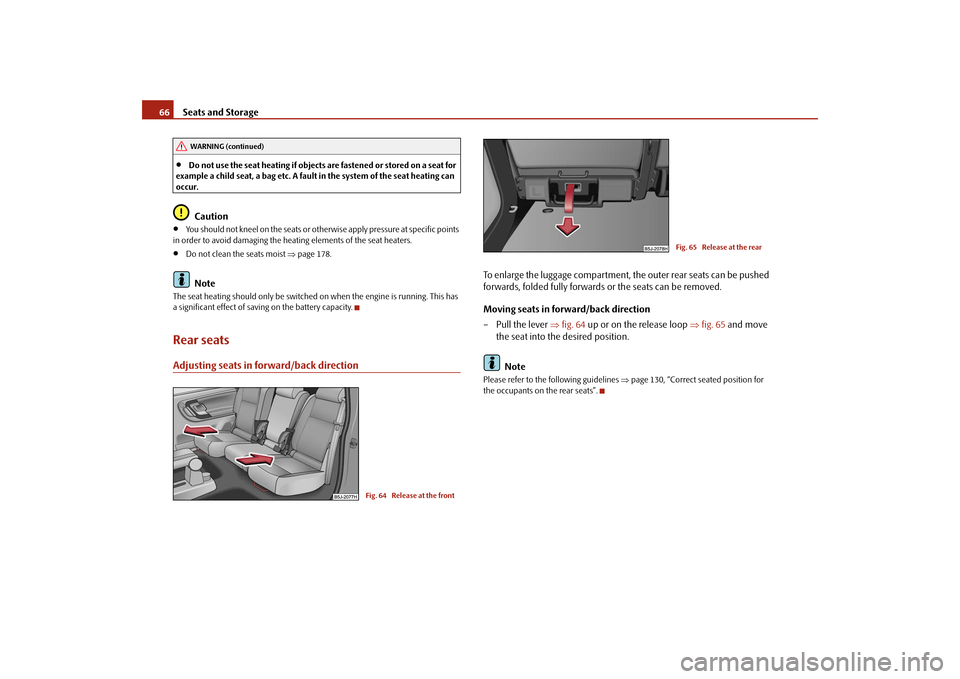
Seats and Storage 66•
Do not use the seat heating if objects are fastened or stored on a seat for
example a child seat, a bag etc. A fault in the system of the seat heating can
occur.Caution
•
You should not kneel on the seats or otherwise apply pressure at specific points
in order to avoid damaging the heating elements of the seat heaters.
•
Do not clean the seats moist ⇒page 178.Note
The seat heating should only be switched on when the engine is running. This has
a significant effect of saving on the battery capacity.Rear seatsAdjusting seats in forward/back direction
To enlarge the luggage compartment, the outer rear seats can be pushed
forwards, folded fully forwards or the seats can be removed.
Moving seats in forward/back direction
– Pull the lever ⇒fig. 64 up or on the release loop ⇒fig. 65 and move
the seat into the desired position.
NotePlease refer to the following guidelines ⇒page 130, “Correct seated position for
the occupants on the rear seats”.
WARNING (continued)
Fig. 64 Release at the front
Fig. 65 Release at the rear
s29g.4.book Page 66 Wednesday, June 17, 2009 9:54 AM
Page 68 of 263
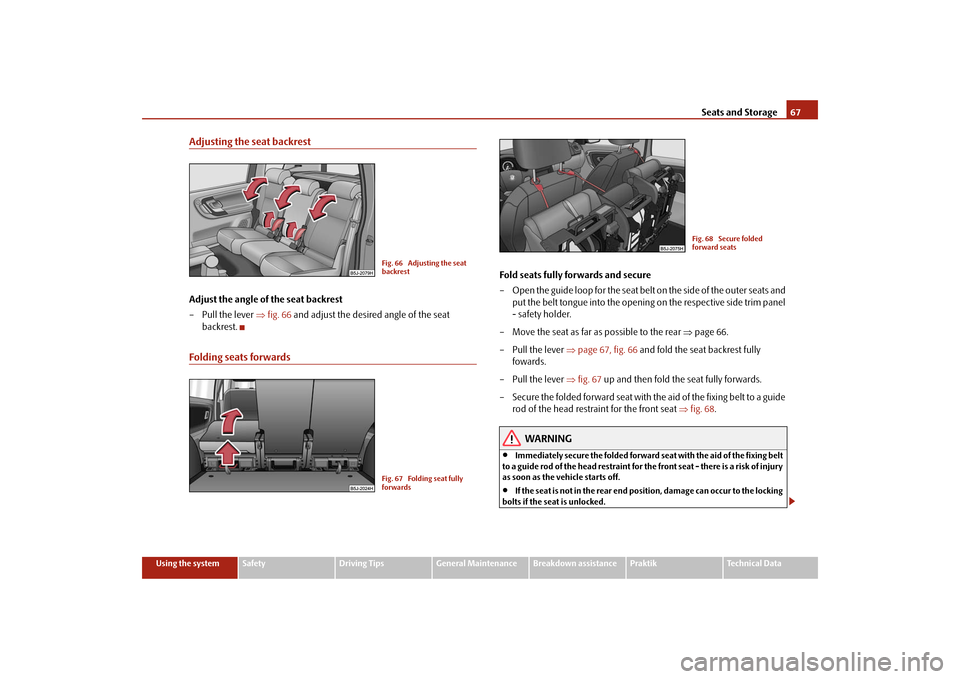
Seats and Storage67
Using the system
Safety
Driving Tips
General Maintenance
Breakdown assistance
Praktik
Technical Data
Adjusting the seat backrestAdjust the angle of the seat backrest
– Pull the lever ⇒fig. 66 and adjust the desired angle of the seat
backrest.Folding seats forwards
Fold seats fully forwards and secure
– Open the guide loop for the seat belt on the side of the outer seats and
put the belt tongue into the opening on the respective side trim panel
- safety holder.
– Move the seat as far as possible to the rear ⇒page 66.
–Pull the lever ⇒page 67, fig. 66 and fold the seat backrest fully
fowards.
–Pull the lever ⇒fig. 67 up and then fold the seat fully forwards.
– Secure the folded forward seat with the aid of the fixing belt to a guide
rod of the head restraint for the front seat ⇒fig. 68.
WARNING
•
Immediately secure the folded forward seat with the aid of the fixing belt
to a guide rod of the head restraint for the front seat - there is a risk of injury
as soon as the vehicle starts off.
•
If the seat is not in the rear end position, damage can occur to the locking
bolts if the seat is unlocked.
Fig. 66 Adjusting the seat
backrestFig. 67 Folding seat fully
forwards
Fig. 68 Secure folded
forward seats
s29g.4.book Page 67 Wednesday, June 17, 2009 9:54 AM
Page 69 of 263
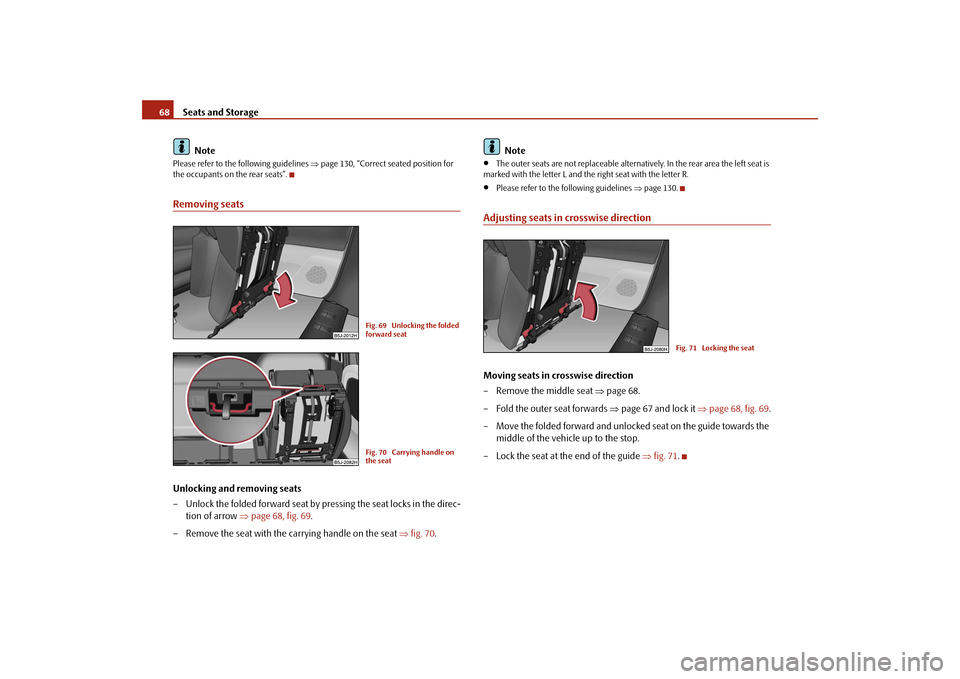
Seats and Storage 68
NotePlease refer to the following guidelines ⇒page 130, “Correct seated position for
the occupants on the rear seats”.Removing seatsUnlocking and removing seats
– Unlock the folded forward seat by pressing the seat locks in the direc-
tion of arrow ⇒page 68, fig. 69.
– Remove the seat with the carrying handle on the seat ⇒fig. 70.Note
•
The outer seats are not replaceable alternatively. In the rear area the left seat is
marked with the letter L and the right seat with the letter R.
•
Please refer to the following guidelines ⇒page 130.
Adjusting seats in crosswise directionMoving seats in crosswise direction
– Remove the middle seat ⇒page 68.
– Fold the outer seat forwards ⇒page 67 and lock it ⇒page 68, fig. 69.
– Move the folded forward and unlocked seat on the guide towards the
middle of the vehicle up to the stop.
– Lock the seat at the end of the guide ⇒fig. 71.
Fig. 69 Unlocking the folded
forward seatFig. 70 Carrying handle on
the seat
Fig. 71 Locking the seat
s29g.4.book Page 68 Wednesday, June 17, 2009 9:54 AM
Page 70 of 263
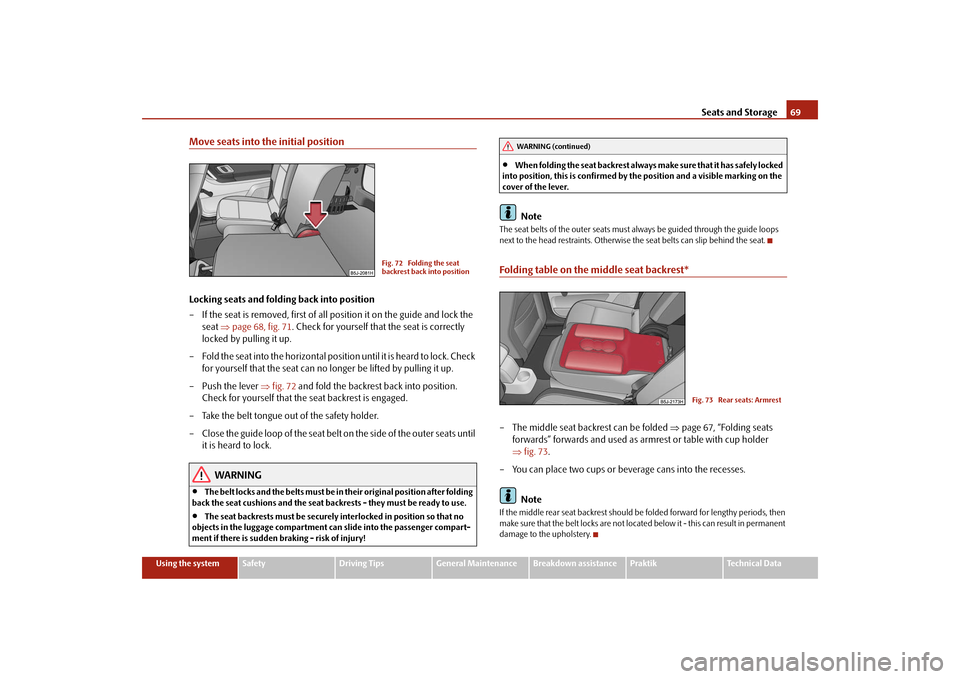
Seats and Storage69
Using the system
Safety
Driving Tips
General Maintenance
Breakdown assistance
Praktik
Technical Data
Move seats into the initial positionLocking seats and folding back into position
– If the seat is removed, first of all position it on the guide and lock the
seat ⇒page 68, fig. 71. Check for yourself that the seat is correctly
locked by pulling it up.
– Fold the seat into the horizontal position until it is heard to lock. Check
for yourself that the seat can no longer be lifted by pulling it up.
– Push the lever ⇒fig. 72 and fold the backrest back into position.
Check for yourself that the seat backrest is engaged.
– Take the belt tongue out of the safety holder.
– C l o s e th e g u id e l o o p o f t h e s ea t b el t o n th e s i de o f t h e o u te r s e a t s u n t il
it is heard to lock.
WARNING
•
The belt locks and the belts must be in their original position after folding
back the seat cushions and the seat backrests - they must be ready to use.
•
The seat backrests must be securely interlocked in position so that no
objects in the luggage compartment can slide into the passenger compart-
ment if there is sudden braking - risk of injury!
•
When folding the seat backrest always make sure that it has safely locked
into position, this is confirmed by the position and a visible marking on the
cover of the lever.Note
The seat belts of the outer seats must always be guided through the guide loops
next to the head restraints. Otherwise the seat belts can slip behind the seat.Folding table on the middle seat backrest*– The middle seat backrest can be folded ⇒page 67, “Folding seats
forwards” forwards and used as armrest or table with cup holder
⇒fig. 73.
– You can place two cups or beverage cans into the recesses.
NoteIf the middle rear seat backrest should be folded forward for lengthy periods, then
make sure that the belt locks are not located below it - this can result in permanent
damage to the upholstery.
Fig. 72 Folding the seat
backrest back into position
WARNING (continued)
Fig. 73 Rear seats: Armrest
s29g.4.book Page 69 Wednesday, June 17, 2009 9:54 AM
Page 71 of 263
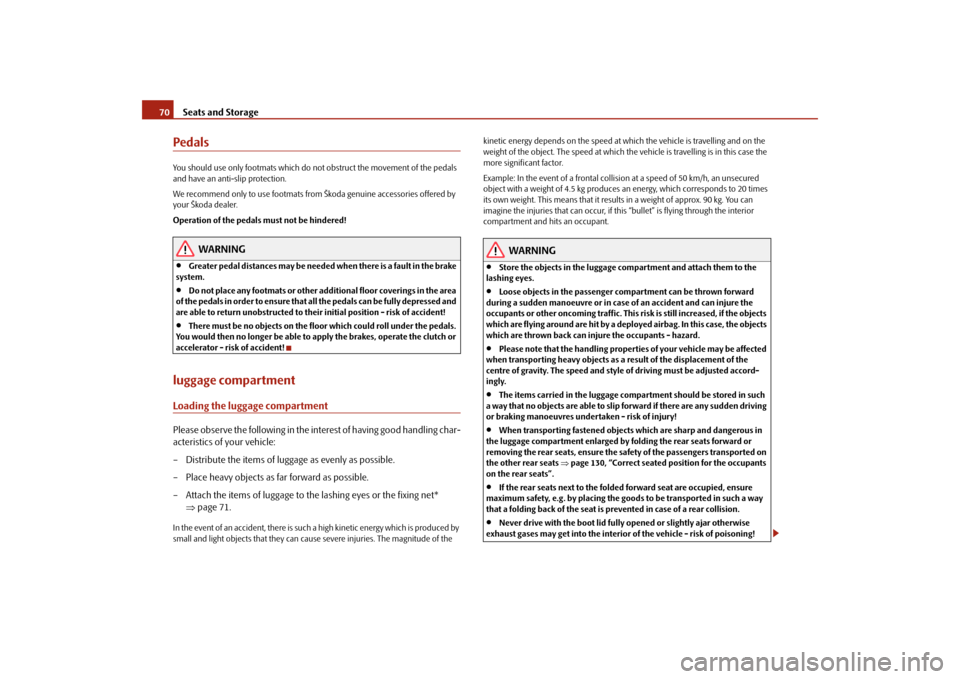
Seats and Storage 70PedalsYou should use only footmats which do not obstruct the movement of the pedals
and have an anti-slip protection.
We recommend only to use footmats from Škoda genuine accessories offered by
your Škoda dealer.
Operation of the pedals must not be hindered!
WARNING
•
Greater pedal distances may be needed when there is a fault in the brake
system.
•
Do not place any footmats or other additional floor coverings in the area
of the pedals in order to ensure that all the pedals can be fully depressed and
are able to return unobstructed to their initial position - risk of accident!
•
There must be no objects on the floor which could roll under the pedals.
You would then no longer be able to apply the brakes, operate the clutch or
accelerator - risk of accident!
luggage compartmentLoading the luggage compartmentPlease observe the following in the interest of having good handling char-
acteristics of your vehicle:
– Distribute the items of luggage as evenly as possible.
– Place heavy objects as far forward as possible.
– Attach the items of luggage to the lashing eyes or the fixing net*
⇒page 71.In the event of an accident, there is such a high kinetic energy which is produced by
small and light objects that they can cause severe injuries. The magnitude of the kinetic energy depends on the speed at which the vehicle is travelling and on the
weight of the object. The speed at which the vehicle is travelling is in this case the
more significant factor.
Example: In the event of a frontal collision at a speed of 50 km/h, an unsecured
object with a weight of 4.5 kg produces an energy, which corresponds to 20 times
its own weight. This means that it results in a weight of approx. 90 kg. You can
imagine the injuries that can occur, if this “bullet” is flying through the interior
compartment and hits an occupant.
WARNING
•
Store the objects in the luggage compartment and attach them to the
lashing eyes.
•
Loose objects in the passenger compartment can be thrown forward
during a sudden manoeuvre or in case of an accident and can injure the
occupants or other oncoming traffic. This risk is still increased, if the objects
which are flying around are hit by a deployed airbag. In this case, the objects
which are thrown back can injure the occupants - hazard.
•
Please note that the handling properties of your vehicle may be affected
when transporting heavy objects as a result of the displacement of the
centre of gravity. The speed and style of driving must be adjusted accord-
ingly.
•
The items carried in the luggage compartment should be stored in such
a way that no objects are able to slip forward if there are any sudden driving
or braking manoeuvres undertaken - risk of injury!
•
When transporting fastened objects which are sharp and dangerous in
the luggage compartment enlarged by folding the rear seats forward or
removing the rear seats, ensure the safety of the passengers transported on
the other rear seats ⇒page 130, “Correct seated position for the occupants
on the rear seats”.
•
If the rear seats next to the folded forward seat are occupied, ensure
maximum safety, e.g. by placing the goods to be transported in such a way
that a folding back of the seat is prevented in case of a rear collision.
•
Never drive with the boot lid fully opened or slightly ajar otherwise
exhaust gases may get into the interior of the vehicle - risk of poisoning!
s29g.4.book Page 70 Wednesday, June 17, 2009 9:54 AM
Page 72 of 263
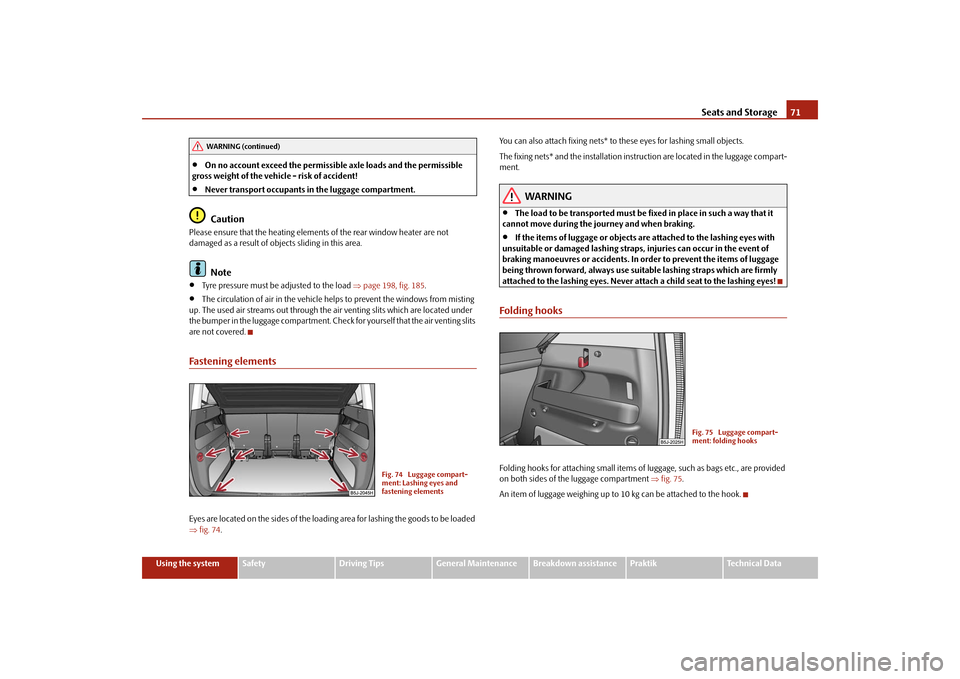
Seats and Storage71
Using the system
Safety
Driving Tips
General Maintenance
Breakdown assistance
Praktik
Technical Data
•
On no account exceed the permissible axle loads and the permissible
gross weight of the vehicle - risk of accident!
•
Never transport occupants in the luggage compartment.Caution
Please ensure that the heating elements of the rear window heater are not
damaged as a result of objects sliding in this area.
Note
•
Tyre pressure must be adjusted to the load ⇒page 198, fig. 185.
•
The circulation of air in the vehicle helps to prevent the windows from misting
up. The used air streams out through the air venting slits which are located under
the bumper in the luggage compartment. Check for yourself that the air venting slits
are not covered.
Fastening elementsEyes are located on the sides of the loading area for lashing the goods to be loaded
⇒fig. 74.You can also attach fixing nets* to these eyes for lashing small objects.
The fixing nets* and the installation instruction are located in the luggage compart-
ment.
WARNING
•
The load to be transported must be fixed in place in such a way that it
cannot move during the journey and when braking.
•
If the items of luggage or objects are attached to the lashing eyes with
unsuitable or damaged lashing straps, injuries can occur in the event of
braking manoeuvres or accidents. In order to prevent the items of luggage
being thrown forward, always use suitable lashing straps which are firmly
attached to the lashing eyes. Never attach a child seat to the lashing eyes!
Folding hooksFolding hooks for attaching small items of luggage, such as bags etc., are provided
on both sides of the luggage compartment ⇒fig. 75.
An item of luggage weighing up to 10 kg can be attached to the hook.
WARNING (continued)
Fig. 74 Luggage compart-
ment: Lashing eyes and
fastening elements
Fig. 75 Luggage compart-
ment: folding hooks
s29g.4.book Page 71 Wednesday, June 17, 2009 9:54 AM
Page 75 of 263
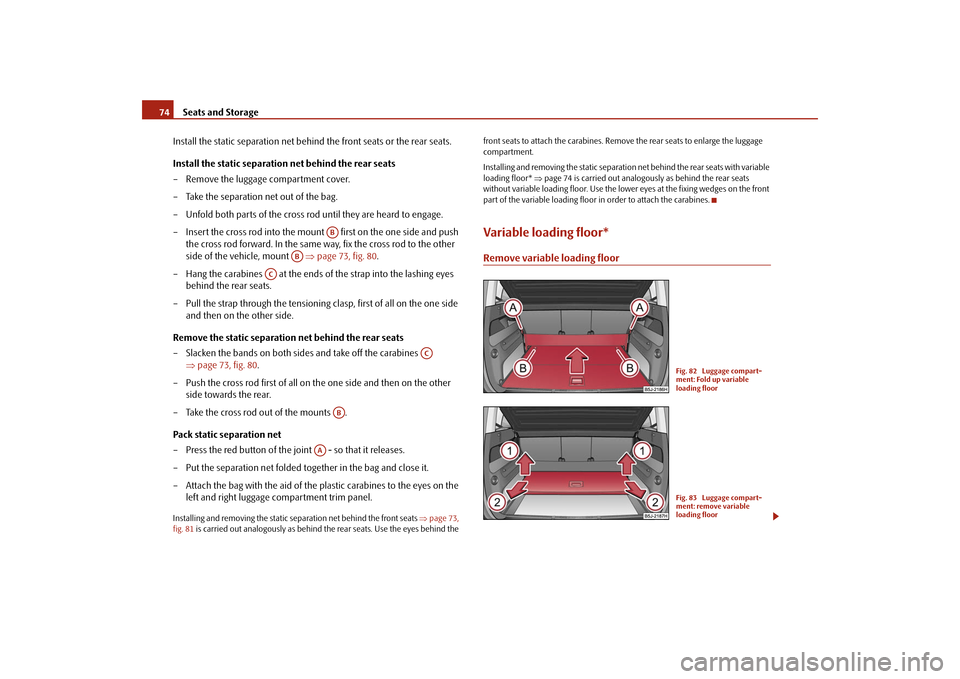
Seats and Storage 74
Install the static separation net behind the front seats or the rear seats.
Install the static separation net behind the rear seats
– Remove the luggage compartment cover.
– Take the separation net out of the bag.
– Unfold both parts of the cross rod until they are heard to engage.
– Insert the cross rod into the mount first on the one side and push
the cross rod forward. In the same way, fix the cross rod to the other
side of the vehicle, mount ⇒page 73, fig. 80.
– Hang the carabines at the ends of the strap into the lashing eyes
behind the rear seats.
– Pull the strap through the tensioning clasp, first of all on the one side
and then on the other side.
Remove the static separation net behind the rear seats
– Slacken the bands on both sides and take off the carabines
⇒page 73, fig. 80.
– Push the cross rod first of all on the one side and then on the other
side towards the rear.
– Take the cross rod out of the mounts .
Pack static separation net
– Press the red button of the joint - so that it releases.
– Put the separation net folded together in the bag and close it.
– Attach the bag with the aid of the plastic carabines to the eyes on the
left and right luggage compartment trim panel.Installing and removing the static separation net behind the front seats ⇒page 73,
fig. 81 is carried out analogously as behind the rear seats. Use the eyes behind the front seats to attach the carabines. Remove the rear seats to enlarge the luggage
compartment.
Installing and removing the static separation net behind the rear seats with variable
loading floor* ⇒page 74 is carried out analogously as behind the rear seats
without variable loading floor. Use the lower eyes at the fixing wedges on the front
part of the variable loading floor in order to attach the carabines.
Variable loading floor*Remove variable loading floor
AB
AB
AC
AC
AB
AA
Fig. 82 Luggage compart-
ment: Fold up variable
loading floorFig. 83 Luggage compart-
ment: remove variable
loading floor
s29g.4.book Page 74 Wednesday, June 17, 2009 9:54 AM
Page 76 of 263
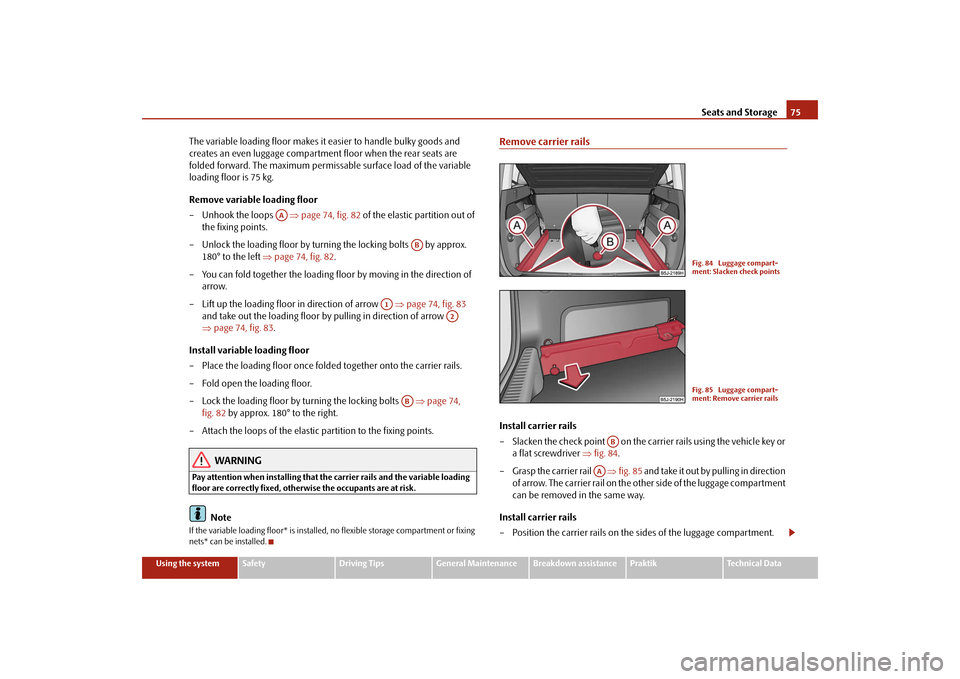
Seats and Storage75
Using the system
Safety
Driving Tips
General Maintenance
Breakdown assistance
Praktik
Technical Data
The variable loading floor makes it easier to handle bulky goods and
creates an even luggage compartment floor when the rear seats are
folded forward. The maximum permissable surface load of the variable
loading floor is 75 kg.
Remove variable loading floor
– Unhook the loops ⇒page 74, fig. 82 of the elastic partition out of
the fixing points.
– Unlock the loading floor by turning the locking bolts by approx.
180° to the left ⇒page 74, fig. 82.
– You can fold together the loading floor by moving in the direction of
arrow.
– Lift up the loading floor in direction of arrow ⇒page 74, fig. 83
and take out the loading floor by pulling in direction of arrow
⇒page 74, fig. 83.
Install variable loading floor
– Place the loading floor once folded together onto the carrier rails.
– Fold open the loading floor.
– Lock the loading floor by turning the locking bolts ⇒page 74,
fig. 82 by approx. 180° to the right.
– Attach the loops of the elastic partition to the fixing points.
WARNING
Pay attention when installing that the carrier rails and the variable loading
floor are correctly fixed, otherwise the occupants are at risk.
Note
If the variable loading floor* is installed, no flexible storage compartment or fixing
nets* can be installed.
Remove carrier railsInstall carrier rails
– Slacken the check point on the carrier rails using the vehicle key or
a flat screwdriver ⇒fig. 84.
– Grasp the carrier rail ⇒fig. 85 and take it out by pulling in direction
of arrow. The carrier rail on the other side of the luggage compartment
can be removed in the same way.
Install carrier rails
– Position the carrier rails on the sides of the luggage compartment.
AA
AB
A1
A2
AB
Fig. 84 Luggage compart-
ment: Slacken check pointsFig. 85 Luggage compart-
ment: Remove carrier rails
AB
AA
s29g.4.book Page 75 Wednesday, June 17, 2009 9:54 AM
Page 78 of 263
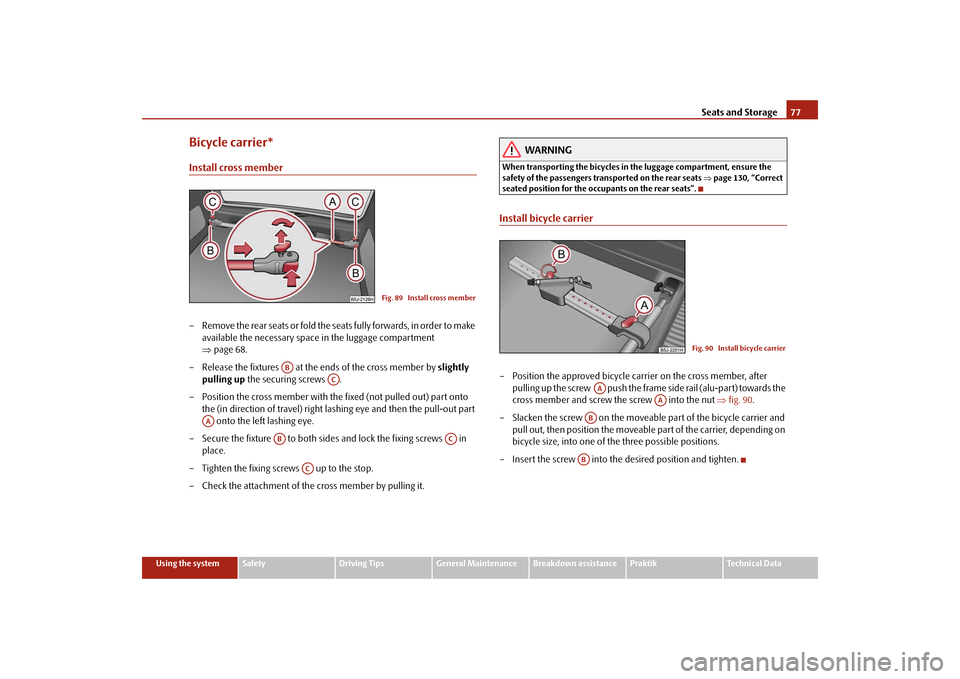
Seats and Storage77
Using the system
Safety
Driving Tips
General Maintenance
Breakdown assistance
Praktik
Technical Data
Bicycle carrier*Install cross member– Remove the rear seats or fold the seats fully forwards, in order to make
available the necessary space in the luggage compartment
⇒page 68.
– Release the fixtures at the ends of the cross member by slightly
pulling up the securing screws .
– Position the cross member with the fixed (not pulled out) part onto
the (in direction of travel) right lashing eye and then the pull-out part
onto the left lashing eye.
– Secure the fixture to both sides and lock the fixing screws in
place.
– Tighten the fixing screws up to the stop.
– Check the attachment of the cross member by pulling it.
WARNING
When transporting the bicycles in the luggage compartment, ensure the
safety of the passengers transported on the rear seats ⇒page 130, “Correct
seated position for the occupants on the rear seats”.Install bicycle carrier– Position the approved bicycle carrier on the cross member, after
pulling up the screw push the frame side rail (alu-part) towards the
cross member and screw the screw into the nut ⇒fig. 90.
– Slacken the screw on the moveable part of the bicycle carrier and
pull out, then position the moveable part of the carrier, depending on
bicycle size, into one of the three possible positions.
– Insert the screw into the desired position and tighten.
Fig. 89 Install cross member
AB
AC
AA
AB
AC
AC
Fig. 90 Install bicycle carrier
AA
AA
ABAB
s29g.4.book Page 77 Wednesday, June 17, 2009 9:54 AM